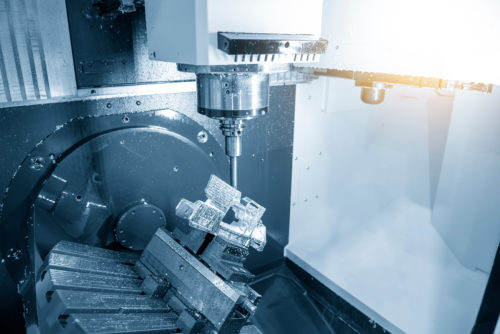What is Multi-Axis Machining?
Multi-axis machining is popular for manufacturers across various industries due to its speed, efficiency, and ability to create products with very few errors. At DACRUZ manufacturing, we offer precision multi-axis machining solutions that can meet the highest industry standards and expectations. To ensure optimal quality and industry compliance, our services are backed by TS compliance, ISO certification, and FDA registration.

Multi-Axis Machining
Multi-axis machining is a type of manufacturing process involving equipment that’s capable of moving in four or more directions. Many applications use this process to manufacture certain parts or sculpt objects using metal or other materials.
There are three main types of multi-axis machining, including:
3-Axis CNC Machining
3-axis machining is the simplest type of multi-axis machining. It involves a fixed workpiece, around which a spindle moves along X, Y, and Z axes. Typically, 3-axis machining works with products of 2D or 2.5D geometries. While it’s possible to machine all six sides of a workpiece with 3-axis machining, each side will require a new potentially costly fixture setup.
4-Axis CNC Machining
4-axis machining includes an A-axis in addition to X, Y, and Z axes. While the other axes allow for linear movement of the spindle, the A-axis rotates the workpiece, enabling the spindle to reach other sides of the workpiece. These systems often rotate the spindle along the Z-axis in vertical machining applications. The added axis eliminates the need for as many fixture setups, making 4-axis machining more cost-effective than 3-axis systems.
5-Axis CNC Machining
5-axis machining uses a rotation of the C- and A-axis or the B- and C-axis. Either the spindle or workpiece may rotate in these setups. 5-axis machines are available in 3+2 axis machines that rotate two axes independent of each other, along with fully continuous options that rotate both rotation axes simultaneously. Both types of 5-axis machines can form complex 3D shapes from workpieces.
Advantages of Multi-Axis Machining
Multi-axis machining offers numerous benefits that make this process ideal for many applications. These advantages include:
- Increased Part Accuracy. Multi-axis machining can produce complex parts in a single setup. This reduces the number of processes and machines required to create a part, resulting in increased geometrical accuracy.
- Optimized Production of Complex Parts. Multi-axis machines often produce highly complex 3D shapes through additional movements that allow for the creation of angles and arcs.
- Long Tool Lifespan. Because the tool or table is constantly tilted, multi-axis machining increases tool lifespan while maintaining the optimal cutting position.
- Provides a Superior Surface Finish. These machines feature a shorter cutting tool that reduces vibrations when moving at high speeds. This results in better surface finishes.
- Lowered Labor Costs. Multi-axis machines don’t require as much manual work such as re-fixturing, which allows for more automated processes and subsequently reduced labor costs.
- Reduction of Scrap/Waste. The efficiency of multi-axis machining means it doesn’t generate as must waste as alternative manufacturing methods.
- Mass Production Capabilities. Increased efficiency and repeatability allow for the mass production of many products.
Applications and Industries
Because of the benefits that come with multi-axis machining, many applications across a wide range of industries use this process. These include:
- Aerospace. Aerospace products and components are often very complex. Multi-axis machining offers a way to produce these parts accurately and efficiently.
- Aviation. Like the aerospace industry, applications in the aviation industry require optimum precision, accuracy, and efficiency, which multi-axis machining provides.
- Automotive. Auto parts feature complex designs that multi-axis machining can produce in mass quantities for automakers.
- Defense. Many products and components in the defense industry require reliable processes that can produce them with consistent quality and efficiency.
- Medical. Medical tools and devices of all types rely on multi-axis machining to develop top-quality products with the utmost precision and accuracy.
Multi-Axis Machining at DACRUZ Manufacturing
Multi-axis machining offers many advantages that meet the needs of a wide variety of applications. At DACRUZ Manufacturing, we offer precision multi-axis machining services that can solve our clients’ challenges and provide results that meet industry standards and individual requirements. To ensure optimal results, we maintain a full staff throughout our operation and work to understand each client’s unique needs.
To learn more about our precision machining capabilities and what we can do for you, contact us today or request a quote.











